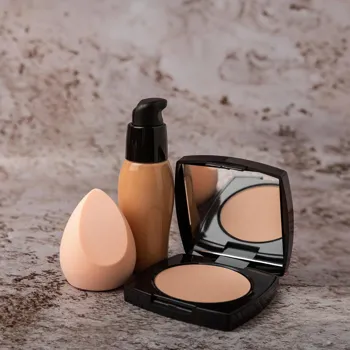Discover the secrets to choosing the perfect foundation for your skin tone. Decode the world of foundations with ease
Finding the perfect foundation can feel like searching for a needle in a haystack, isn't
it? Especially with so many brands and types available in the market today. But don't worry, getting that flawless base is definitely achievable!

The secret lies in understanding your skin type and choosing a formula that complements it. So, let's dive in and decode the world of foundations, shall we? We'll talk about how to pick the absolutely perfect one for you.
Identify your skin type: oily, dry, combination, sensitive
The first step is figuring out your skin type. Is it oily, dry, combination, or sensitive? Oily skin is often characterised by excess shine, enlarged pores, and a tendency to break out. Dry skin, on the other hand, feels tight, flaky, and can even be itchy.

Combination skin is a mix of both, usually with an oily T-zone (forehead, nose, and chin) and dry cheeks. Sensitive skin is easily irritated, prone to redness, and may react to certain ingredients. Once you've identified your skin type, you're halfway there!
Remember, look out for signs of how your skin behaves throughout the day. This information will be super helpful when selecting the right foundation formula!
Choose oil-free, non-comedogenic foundations with matte finish for oily skin
For oily skin, look for foundations that are oil-free, non-comedogenic (meaning they won't clog pores), and have a matte finish. Powder foundations and liquid foundations with a matte formula are great options. They'll help control shine and keep your skin looking fresh throughout the day.

Ingredients like silica and clay can also help absorb excess oil. Avoid foundations that are too dewy or have a lot of shimmer, as they can accentuate the oiliness. Setting your foundation with a powder will also help to keep the oil at bay and prolong the wear time.
Blotting papers are your best friend for touch-ups during the day. Don't use foundations with too much oils, as this will cause break outs and cause skin irritation overall.
Choose hydrating foundation with dewy finish for dry skin
If you have dry skin, you'll need a foundation that will hydrate and nourish your skin. Look for foundations with a dewy or satin finish, and ingredients like hyaluronic acid, glycerin, and shea butter. Cream foundations and liquid foundations with moisturizing properties are ideal.

Avoid matte foundations, as they can accentuate dryness and make your skin look flaky. Before applying foundation, make sure to moisturize your skin well. You can even mix a drop or two of facial oil into your foundation for extra hydration.
Exfoliating regularly will also help to remove dead skin cells and create a smoother canvas for your foundation. Try lighter application for coverage so that the skin does not appear with crack lines.
Combination skin care: use liquid foundation, adjust for zones, prime well, avoid heaviness
Combination skin can be tricky, as you need to address both oily and dry areas. A good option is a liquid foundation with a natural or semi-matte finish. You can also use different foundations on different areas of your face.

For example, a matte foundation on the T-zone and a dewy foundation on the cheeks. Pay attention to how your skin behaves throughout the day and adjust your routine accordingly.
Priming is key for combination skin, so use a primer that addresses your specific concerns, such as oil control or hydration. Avoid using very heavy foundations as this may cause skin clogs. Experiment to see which works best for you and your skin sensitivities.
Sensitive skin needs gentle, hypoallergenic foundations with soothing ingredients
Sensitive skin requires extra care and attention. Look for foundations that are hypoallergenic, fragrance-free, and non-comedogenic. Mineral foundations are often a good choice, as they contain fewer ingredients and are less likely to cause irritation.

Always do a patch test before applying any new foundation to your entire face. Apply a small amount to your jawline and wait 24 hours to see if any reaction occurs. Avoid foundations with harsh chemicals, parabens, and artificial fragrances.
Look for foundations that contain soothing ingredients like aloe vera and chamomile. Gentle application with a soft brush or sponge will help to minimize irritation. Always be gentle with your skin and remove makeup carefully at the end of the day.
Choosing the right foundation shade is key for a flawless look
Now, let's talk about shades. Finding the right shade is crucial for a natural-looking finish. The best way to find your perfect match is to swatch the foundation on your jawline in natural light. The shade that disappears into your skin is the right one for you.

Don't test the foundation on your hand or wrist, as the skin tone there is different from your face. Keep in mind that your skin tone may change slightly throughout the year, so you may need to adjust your foundation shade accordingly.
It's always a good idea to have two shades on hand, one for summer and one for winter. Ask for samples at makeup counters so you're confident before you commit.
Application technique is key for flawless makeup; experiment to find what works best
Finally, application is key to achieving a flawless finish. Use a makeup brush, sponge, or your fingers, depending on your preference and the type of foundation you're using. Start with a small amount of foundation and blend it outwards from the center of your face. Build up the coverage as needed.

Don't forget to blend along your jawline and hairline to avoid harsh lines. Set your foundation with a powder to help it last longer and control shine. Remember, practice makes perfect, so don't be afraid to experiment with different techniques and products until you find what works best for you.
With a little effort and research, you can definitely find the perfect foundation for your skin type!
AI Generated Content. Glance/InMobi shall have no liability for the content










